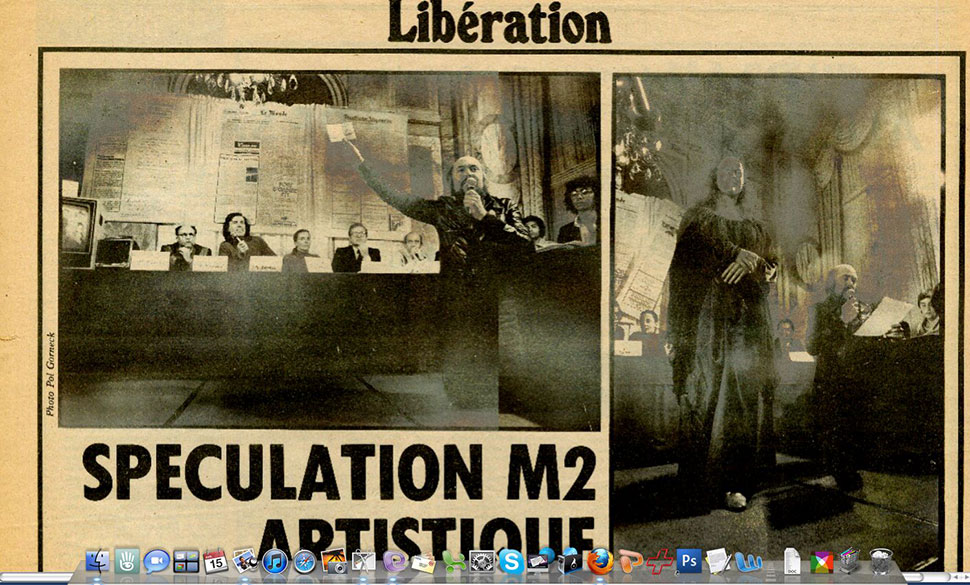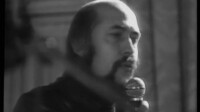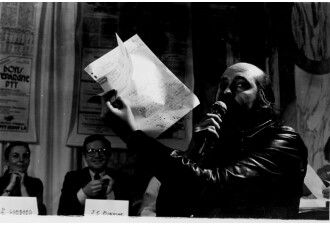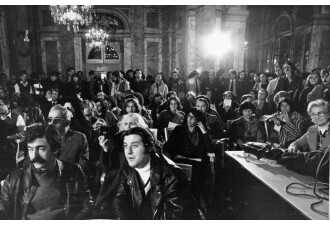Le M2 artistique au Crillon
Following its first publication of the M2 in the press, notably in the newspaper Le Monde, Fred Forest is launching a new international invitation to tender for the sale of an M2 to the highest bidder. This rare economic procedure allows a purchase proposal to be sent to the designated bailiff in the form of a sealed envelope.
Contents :
- 1977 Le Crillon
- 2022 Le M2 artistique de Fred Forest
- 1977 M2 artistique au Crillon
- 1977 LE MÈTRE CARRE ARTISTIQUE
- 2019 Le M2 artistique
1977 Le Crillon
Following its first publication of the M2 in the press, notably in the newspaper Le Monde, Fred Forest is launching a new international invitation to tender for the sale of an M2 to the highest bidder. This rare economic procedure involves sending a purchase proposal in the form of a sealed envelope to the designated bailiff.
On the appointed day, the bailiff will open all the envelopes received and the contract will be offered to the highest bidder. The artist has appointed Maître Le Marec, a bailiff in Paris, to carry out the operation in accordance with the law.
But Fred Forest, who is something of a media expert, knows full well that the place where the envelopes will be opened is a factor of the utmost importance in his plan for success.
He contacted all the Parisian luxury hotels one by one and finally found an amicable arrangement with the Hôtel Crillon on Place de la Concorde. He then organised a public debate between art critics, leading lawyers and property professionals in order to determine as closely as possible the status of the square M2. He stepped up communication by sending out press releases to all the professions concerned, which he passed on via AFP.
On the day the envelopes were to be opened, a large audience thronged the grand salon at the Crillon, where the artist had set up a large table on a podium around which the various experts were seated. Among them were the representative of the FNAIM, the lawyer representing Maître Paul Lombard, Maître Jean-Claude Binoche, Philippe Lette international lawyer, Stéphane Rona Director of the magazine Belge + - 0, and the artist Hervé Fisher. Although he was travelling in India, Pierre Restany himself was present in the form of a video transmission from India.
But the bailiff was kept waiting, and when he finally arrived, it was to take the floor and declare that the Public Prosecutor had just notified him that he was forbidden to open the submissions. Panic-stricken, under the glare of the many photographers present, he didn't even take the time to get Fred Forest to sign a discharge and ran out of the room, throwing a bundle of envelopes on the floor behind him. The artist and his friends picked them up and Forest declared that, given the failure of the law enforcement officers, he would open the envelopes himself under his supervision.
An office constituted by close friends of the artist (the Charpentier family) proceeds to the opening, classifies the participations rigorously and hands the submissions to Forest who reads them. The first incident he had not foreseen was when an artist by the name of Paolo Calia, whose artistic practice consists of reconstituting historical paintings with living figures, entered the room holding an actress who was supposed to represent the Mona Lisa. From the experts' table, Maître Binoche immediately exclaimed: "Let's put the Mona Lisa up for sale! The opening of the envelopes continued at an accelerated pace in front of a mixed audience, including autonomes (leftist activists) shouting their usual slogans against the proponents of capitalism with a degree of violence. Suddenly, there were several explosions in the audience, with a group of Punks, including the very famous Titus, still wearing his battle-dress, firing off their weapons. Thick smoke spread through the reception gallery, which was emptied in a matter of seconds by the panic. The CRS (French riot police), called in as reinforcements by the management, landed on the carpets of the Crillon, truncheons in hand, and turned the reception area into their stronghold. They telephoned upstairs, where punks were scaring off the chambermaids. Finally, some of the public returned to the main gallery where Forest, unperturbed, continued to read the offers. The punks come back at him and try in vain to pour a bottle of ketchup over his skull. A bottle was grabbed from the kitchen next door. He knows he's won: the next day there'll be a flood of press coverage. He congratulated himself on having been able to involve the CRS themselves in his action as extras. Three curators interviewed him in the director's office. Sociological art is now all the rage... A full-page spread on the back cover of LIBE the following day confirms this judgement.
2022 Le M2 artistique de Fred Forest
06/10/2022
This "work" is made up of a succession of facts and events that make it difficult at first sight to read as a whole, given its complexity. The project began under the name of Mètre carré artistique (Artistic square metre), then became Mètre carré non artistique (Non-artistic square metre) and was extended by the "Appel d'offre international. Artistic M2 speculation" published in the press. It should also be noted that this notion of the "artistic square metre" was to be the thematic starting point for a number of other projects, from the Territoire du mètre carré in Anserville (from 1980) to the Territoire des réseaux in 1996, and was to be cited independently each time, depending on the date of completion.
The artist's aim with this work, which was to last throughout his life, was to create a narrative which, depending on the period and social and technical developments, would create sequences of moments illustrating current events in the broadest sense of the word.
THE ARTISTIC SQUARE METRE
At the beginning of 1977, Fred Forest created a non-trading property company known as the "artistic square metre", whose articles of association were legally deposited with a notary, where he proceeded to open a SCI (non-trading property company) and then bought a plot of land in the commune of Filingues, near Annemasse, from a farmer. With a surface area of twenty square metres, divided into twenty equal plots, he used a land registry surveyor to divide the land into parcels.
A few weeks later, an advertisement entitled "Placez vos capitaux à deux pas de la frontière suisse" ("Place your capital just a stone's throw from the Swiss border") appeared in the daily newspaper Le Monde on 10 March 1977, with the aim of selling "artistic square metres", corresponding to the plots recorded in the land register of the land acquired by the artist, at an auction scheduled for 22 March 1977 at the Espace Cardin in Paris. This "work" was initially numbered 83 bis "M2 artistique" in the catalogue. The day after the bid was published in the press, the artist was summoned by the fraud control department of the Ministry of the Interior on suspicion of false advertising. At the request of the public prosecutor, a report was drawn up by brigadiers from the Annemasse gendarmerie who had visited the "artistic square metre" plots, attesting to the non-artistic nature of the site. We should not forget to mention that this advertising placard was published at the artist's request, and not without difficulty, not in the pages devoted to art at the time but in that of the economy so that the transgression would be even greater. Forest had to spend more than two full years getting his advertisement accepted, and had numerous meetings with his administrator Jacques Sauvageot, who proved to be a very useful accomplice, in order to convince the Director of Editorial Services, who was firmly opposed to the project, on the pretext that a serious newspaper like Le Monde could not indulge in such fantasies... Jacques Sauvageot whispered in my ear the solution that was, in his opinion, the best way to overcome the resistance from the editor-in-chief. You need to get another national partner to do your work. This will reassure all those in the company who are opposed to your publication. So here I am, without any contacts, looking for sponsorship. Once again, I could only rely on myself, so I had to use my imagination. I successively approached France Soir, Le Parisien and L'Aurore, to no avail. Then I thought of national radio, where Jacques Paoli had a popular daily programme called Carré bleu. Carré bleu and my white squares were to work in perfect synergy.
The deal was in the bag!
THE NON-ARTISTIC SQUARE METRE
Following this questioning of the quality and artistic status of Forest's proposal, he made the matter known in a press release, leading to the publication of news briefs and articles in general and business newspapers, relaying the decision.
On 20 March 1977, on the orders of the Public Prosecutor's Office, the Chambre de Discipline des Commissaires-priseurs prohibited Maître Binoche from selling the "artistic square metre", prompting Fred Forest to offer, as a replacement, a "non-artistic square metre" (numbered 83 ter in the sales catalogue), namely a piece of white fabric, with a surface area of one square metre, for which the artist specified the purchase cost, i.e. fifty-nine francs. This textile was placed on the floor at the entrance to the auction room, where it was trampled underfoot by the audience and participants, and then put up for sale, to fetch the final bid of six thousand five hundred francs.
It's clear that Fred Forest is bending the rules of the law in the name of art, transforming a worthless piece of land into a work of art. He has embarrassed the Public Prosecutor and the guardians of the law in the face of a case whose nature escapes their usual criteria. In doing so, Fred Forest created an event by alerting the press with press releases that soon had an impact, because this artist, who works with the tools of modern communication rather than with a paintbrush, is above all a brilliant producer of events.
This action was continued a few months later. On 20 September 1977, Le Monde published a second advertising insert produced by Forest, entitled "Appel d'offre international. Artistic M2 speculation". It launched an international invitation to tender: an innovative financial technique that enabled Antoine Riboud to become the leader in France by appropriating the market through a famous takeover bid.
Fred Forest knew Antoine Riboud well, having visited him on his return from Algeria in the Paris suburbs, where they had to dine on the floor on a carpet, the impoverished artist not having a single piece of furniture in the house...
In short, in his new insert in Le Monde, the artist invited, in a new provocation, potential buyers to return their promises to purchase in the amount of their choice, before 15 October 1977. The advertisement was also published in the German daily Frankfurter Allgemeine; an attempt to appear in Newsweek, in the United States, was partly aborted, as the newspaper's management did not finally grasp the nature or status of the advertisement submitted by Fred Forest. A press conference presenting the project and its various stages was organised in the salons of the Hôtel Crillon on 26 October 1977; the envelopes containing the promises to purchase, sent to Maître Le Marec, bailiff, were opened in turn and announced to the public present. The end of the session was disrupted by the unexpected intervention of a group of "punks". Fred Forest comments: "Appropriation of the information space in order to get across a critical message about the practices of property speculation that were particularly flourishing at the time.
The concept of the action undertaken here is based on the creation of a device aimed at creating a critical 'work of information'. A work that will take shape and exist within the very body of mainstream information, using national media to do so. The primary aim of the work is to denounce speculative practices (linked to particularly juicy financial scandals at the time, including those of the Garantie Foncière and the four Willot brothers, nicknamed the Dalton brothers) by parodying speculation in the property market with the unbridled and joyous speculation in the art market. In order to create this media 'event', the artist puts in place a communication strategy [...]".
The "non-artistic m2", as we have said, is nothing more than a vulgar piece of white rag, bought that very morning for the modest sum of 59 FF, and resold that very evening at an enormous profit! Forest's demonstration gives us a 'glimpse' of the mechanisms of speculation, staging them with their own ritual in the social and professional setting where they are usually carried out.
Speculation, as such, is back in the saddle in the 'media space'. Pundits and commentators are having a field day. In total ignorance, they are contributing to the creation of an already historic work of art. The press coverage, both written and audiovisual, is considerable. The transgression of the price still played a dynamic role, as did that of the official authorities. Because of the acute sensitivity of the media point of view to the circulation and the treatment of the information in our societies, Forest knew how to divert and "subvert", by investing them of the interior, the media. Subjugating them to the cause of his demonstration, in other words, to that of his "work".
A work that can be understood as a constellation of information that his action brings to light through the force of the device and the media event he has created".
Extract from the artist's personal website: target=_new>http://www.webnetmuseum.org
Copyrigth Fred Forest /ADAGP
Sources :
Archives INA – Fonds Fred Forest : AR E ORI 00013262 INA 14 ;
AR E ORI 00013262 INA 21 ; AR E ORI 00013262 INA 30
Documents presented: extracts from the catalogue of the auction organised at the Espace Cardin (March 1977); report on the whole event (by Fred Forest); certificate of authenticity drawn up by Pierre Restany; report on the conference at the Hôtel Crillon.
1977 M2 artistique au Crillon
This project, set up in 1977, was to develop over time, without ever being interrupted... until the artist's death. Today, the Territoire is "moving" into the networks and becoming the "Territoire of Territories" in a logical sequence, contingent on its nature and purpose, in relation to the theories of Sociological Art and the Aesthetics of Communication. (See in particular the texts on this subject by Pierre Restany and Annick Bureaud). This is the transition from the material to the virtual, and then the transition to network art! At the outset, the very nature of the concept of Territoire as an "open work", as a game of simulation and communication, interactive in nature, puts the project in a position to evolve in line with changes in our environment and technological developments. This project itself follows on from the media and artistic vicissitudes of the 'square metre'. The 'Territoire' work is located 50 km north-west of Paris, in the commune of Anserville in the Oise department. Despite the move, it remains the historical reference point for all current developments. It is materialised in the form of a plot of land and a building, the whole of which constitutes an 'independent state' that responds only to its own rules and laws, which are, of course, established and modified by the artist, who decides on the measures to be taken according to the urgencies of the moment. His yardstick is the M2. The buildings house 'Power' and its various departments. The rooms are laid out according to functions, symbols and activities specific to artistic practice. The Territorial Administration is ensured at all levels of decision-making and execution by the artist-Chairman, who performs all the functions from a perspective based solely on the imaginary created, generated and induced by the system itself. Once accepted by the Territorial Administration, it is possible to become a full citizen of the Territory by subscribing for a square metre. This subscription entitles the holder to the relevant titles, which are official documents signed by the President-Artist. Once this formality has been completed, citizens are automatically admitted to take part in the communication game that has been initiated, which is also intended to be a laboratory of ideas for the future. They can position themselves as "passive" players or as "active" participants in the aesthetic-parodic operation of the game. In all cases, they receive regular information on the life of the Territory, which 'feeds' the evolving work they own. With the move to the networks and the transition to the virtual Territory, the very notion of "territory" is being fundamentally questioned! The foot that lands on its soil to appropriate it can no longer be anything other than universal and "planetary". The notion of borders is dissolving like sugar in a glass of water... We need to reinvent the way we live, feel, think and... sharing with others! We need to invent the "Territory of networks".
The Crillon phase corresponds to a sale of 1 M2 put up for sale by press announcement in the form of a subscription staged in Paris at the Hôtel Crillon in front of a committee of experts, which will give rise to a series of twists and turns.
1977 LE MÈTRE CARRE ARTISTIQUE
ESPACE MÉDIATIQUE (presse écrite, radio, T.V.) HÔTEL LE CRILLON – ESPACE CARDIN, PARIS.
MARS-OCTOBRE 1977
CONCEPT :
Appropriating the space of information in order to get across a critical message about the practices of property speculation that were particularly flourishing at the time.
The concept of the action undertaken here is based on the creation of a device aimed at creating a critical 'work of information'. A work that will take shape and exist in the very body of mainstream information, using national media to do so. The primary aim of the work is to denounce speculative practices (linked to particularly juicy financial scandals at the time, including those of the Garantie Foncière and the four Willot brothers, nicknamed the Dalton brothers) by parodying speculation in the property market with the unbridled and joyous speculation in the art market.
In order to create this media 'event', the artist is putting in place a communication strategy based on four fundamental points:
- Creation of a société civile immobilière (non-trading property company) in the legal form before a notary.
- Purchase of a 5m x 4m plot of land on the Swiss border, divided by an expert surveyor into 20 plots, known as "artistic M2s" and entered in the land register. These parcels of land, with their very special status, were "marketed" by the "Société civile immobilière dite du mètre-carré".
- Publication in the newspaper Le Monde, dated 10 March 1978, of an advertisement occupying a third of a page, under the headline: "Placez vos capitaux à deux pas de la frontière suisse" ("Place your capital a stone's throw from the Swiss border").
- The first instalment of "Artistic M2" is put up for sale at public auction under the hammer of Jean-Claude Binoche at the Espace Cardin during an annual art auction featuring paintings by Picasso, Max Ernst, Fernand Léger and others. The sale is scheduled for 22 March 1977 at 9pm.
The day after this insert was published in Le Monde, Fred Forest was summoned to the offices of the fraud control department of the Ministry of the Interior on the Quai de Gesvres.
He was questioned at length about his intentions and motivations, before being threatened with a charge of "false advertising" under the Royer law. One of the three police officers present then put in front of him a report from the Annemasse gendarmerie, drawn up at the request of the public prosecutor, attesting after a visit by the gendarmerie brigadier and transport to the site, that the disputed land in question had nothing, no nothing, to do with art! The artist then respectfully pointed out to the police officers who were questioning him that a gendarme is in no way qualified to judge matters of art, as he is in no way an expert in this field.
As you can imagine, all the conditions were now in place to create an event and give real status to Fred Forest's 'artistic M2', with the unexpected and involuntary collaboration of a Sergeant from the Annemasse Gendarmerie... The artist, who had just left the Ministry of the Interior, was content to send a simple press release to the relevant press agencies. The result was not long in coming: the next day, an avalanche of articles in the press, particularly in the business press.
A new twist was added to the story: two days before the planned and announced sale, the Chambre de Discipline des Commissaires-priseurs (Auctioneers' Disciplinary Chamber), acting on orders from the Public Prosecutor's Office, prohibited Maître Binoche from auctioning the "artistic M2". Faced with this unavoidable decision, which could not be appealed immediately, Forest came up with an appropriate response, proposing to replace the "artistic M2", which had been banned from the sale, with the "non-artistic M2"! A vulgar piece of white fabric, measuring one metre by one metre, which was bought by a collector for the not inconsiderable sum at the time of... 6,500 FF!
In the meantime, the Renseignements Généraux in Lyon were asked to investigate! Henri Chambon of TF1 made the first on-the-spot report. The plot thickens. The "non-artistic M2", as we have said, was just a vulgar piece of white rag, bought that very morning for the modest sum of 59 FF and resold that evening at a huge profit! Forest's demonstration gives us a 'glimpse' of the mechanisms of speculation, staging them with their own ritual in the social and professional setting where they are usually carried out. Speculation, as such, is back in the saddle in the 'media space'. Pundits and commentators are having a field day. In total ignorance, they are contributing to the creation of an already historic work of art. The impact of the press, both written and audiovisual, is considerable. With his acute sensitivity to the circulation and processing of information in our societies, Forest has been able to hijack and 'subvert' the media by taking them over from within. Subjugating them to the cause of his demonstration, in other words, to that of his "work". A work in the form of a constellation of information that his action brings to the fore through the force of the device and the media event created.
The action of the "artistic M2", activated by the artist, would be extended in the following months with other advertising inserts in the newspaper Le Monde. Relaunched in the form of an "international call for tenders", the "artistic M2" was to have new adventures, this time in the salons of the Hôtel Crillon, reserved for art and speculation for the occasion.
2019 Le M2 artistique
FROM THE ARTISTIC M2, TO THE TERRITORY OF THE ARTISTIC M2, TO ARRIVE AT THE PLANETARY M2 ...




LONG BIOGRAPHY OF FRED FOREST
Fred Forest has a special place in contemporary art. Both by his personality and by his pioneering practices which mark his work. He is mainly known today for having used one by one most of the communication media that have appeared over the last fifty years. He is co-founder of three artistic movements: those of sociological art, the aesthetics of communication and ethics in art.
He represented France at the 12th São Paulo Biennale (Communication Prize) in 1973, at the 37th Venice Biennale in 1976 and at Documenta 6 in Kassel in 1977.
EXHIBITION AT THE CENTRE POMPIDOU FROM JANUARY 24 TO OCTOBER 14, 2024























